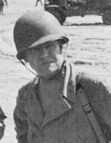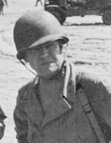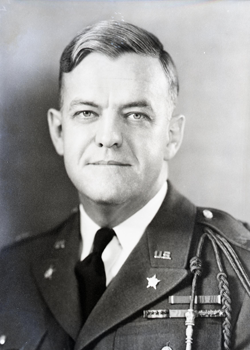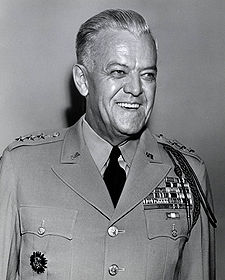The son of John Logan and Martha Washington (Smith) Bruce, he was born in St. Louis, Missouri, on September 14, 1894, and grew up in Texas. He graduated from the Agricultural and Mechanical College of Texas (now Texas A&M University), which awarded him a doctorate of laws, and in 1917 entered the army. He returned from combat duty in France in 1918 as a lieutenant colonel after action with the Second Division in France and service with occupation forces in Germany. He married Roberta Linnell Kennedy in 1920 and taught military science and tactics at Allen Academy in Bryan. The couple had three children. Between the wars Bruce did tours of duty at the Infantry School, foreign duty in Panama, historical work at the Army War College, and service on the War Department general staff, where he revised textbooks on military doctrine. In the early 1940s he organized and commanded the Tank Destroyer Center at Fort Hood. In 1943 he assumed command of the Seventy-seventh Infantry, which he led through heavy fighting in the Guam, Leyte, and Ryukyu campaigns. He and his men buried war correspondent Ernie Pyle on Ie Shima, Ryukyu Islands, in 1945. After Japan surrendered, Bruce served as military governor of Hokkaido. In 1947 he returned to the United States, where he filled various staff positions. He later commanded the Seventh Division in Korea. Bruce, who received medals and decorations for his service from both the United States and other governments, retired in 1954 to serve as president of the University of Houston. The university became state-supported during his term of office, and in 1956 he was made its first chancellor. He was a Mason and a Shriner and served as president of the Houston Chamber of Commerce. Bruce Memorial Hall, a housing complex at Fort Hood, is named in his honor. He died on July 28, 1969, and was buried at Arlington National Cemetery.
The son of John Logan and Martha Washington (Smith) Bruce, he was born in St. Louis, Missouri, on September 14, 1894, and grew up in Texas. He graduated from the Agricultural and Mechanical College of Texas (now Texas A&M University), which awarded him a doctorate of laws, and in 1917 entered the army. He returned from combat duty in France in 1918 as a lieutenant colonel after action with the Second Division in France and service with occupation forces in Germany. He married Roberta Linnell Kennedy in 1920 and taught military science and tactics at Allen Academy in Bryan. The couple had three children. Between the wars Bruce did tours of duty at the Infantry School, foreign duty in Panama, historical work at the Army War College, and service on the War Department general staff, where he revised textbooks on military doctrine. In the early 1940s he organized and commanded the Tank Destroyer Center at Fort Hood. In 1943 he assumed command of the Seventy-seventh Infantry, which he led through heavy fighting in the Guam, Leyte, and Ryukyu campaigns. He and his men buried war correspondent Ernie Pyle on Ie Shima, Ryukyu Islands, in 1945. After Japan surrendered, Bruce served as military governor of Hokkaido. In 1947 he returned to the United States, where he filled various staff positions. He later commanded the Seventh Division in Korea. Bruce, who received medals and decorations for his service from both the United States and other governments, retired in 1954 to serve as president of the University of Houston. The university became state-supported during his term of office, and in 1956 he was made its first chancellor. He was a Mason and a Shriner and served as president of the Houston Chamber of Commerce. Bruce Memorial Hall, a housing complex at Fort Hood, is named in his honor. He died on July 28, 1969, and was buried at Arlington National Cemetery.
Family Members
Sponsored by Ancestry
Advertisement
Explore more
Sponsored by Ancestry
Advertisement









